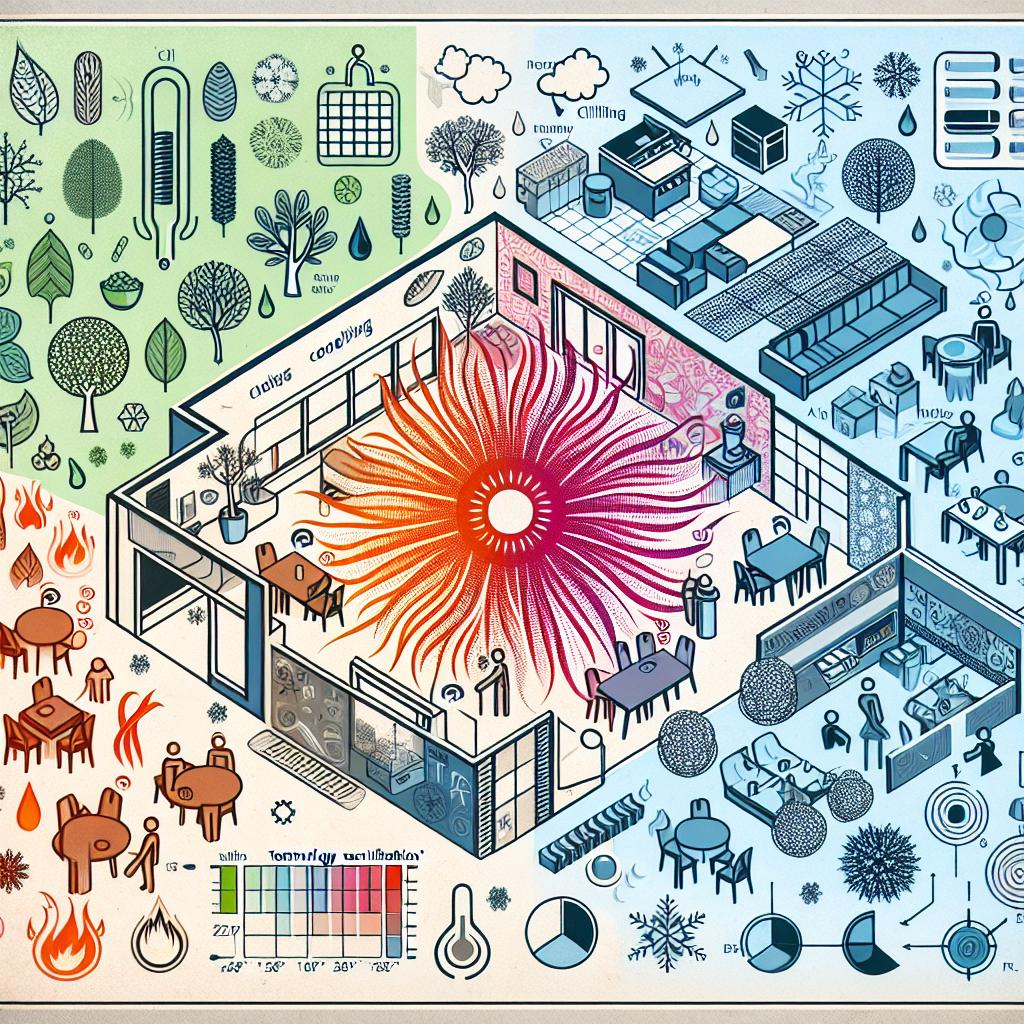Introduction:
As summer sizzles and diners flock to their favorite eateries, maintaining a comfortable atmosphere becomes crucial for any restaurant. Enter the mini-split AC system-a compact, energy-efficient solution that promises to cool even the hottest of kitchens and dining areas. Tho, when it comes to designing an optimal mini-split setup, many restaurateurs find themselves navigating a minefield of potential pitfalls. Whether it’s miscalculating load requirements, overlooking ventilation, or misjudging the placement of units, these common mistakes can turn a seemingly straightforward cooling solution into a recipe for discomfort. In this article, we’ll explore the key missteps to avoid when designing a mini-split AC system for your restaurant, ensuring that your establishment remains a refreshing retreat all season long.
Understanding Cooling Needs for Various Restaurant Layouts
When designing a mini split AC system for a restaurant, it’s essential to recognize that different layouts demand tailored cooling strategies. Open-concept spaces require a distinct approach compared to segmented dining areas. As an example:
- Open Layouts: utilize multiple indoor units strategically placed to ensure airflow distribution and uniform cooling across the vast space.
- Segmented Areas: focus on dedicated zones that allow for individual temperature control, leading to enhanced comfort and energy efficiency.
The cooling needs of specific zones also depend on their purposes.Areas such as the kitchen experience intense heat from cooking appliances, necessitating a more robust system. Conversely, quieter dining spaces might require less cooling. Consider the following factors when planning:
| area | Cooling Requirement |
|---|---|
| Kitchen | High-capacity, constant cooling |
| Dining Room | Moderate cooling with individual control |
| Bar Area | Low to moderate cooling for comfort |
Selecting the Right Mini Split System for Energy Efficiency
When searching for a mini split system optimized for energy efficiency, it’s essential to focus on units that are equipped with the latest technology. Look for systems featuring inverter-driven compressors, which adjust their speed based on the cooling or heating demand, minimizing energy waste. Additionally, choosing a model with a high Seasonal Energy Efficiency Ratio (SEER) rating can greatly impact long-term energy costs. Consider units that integrate features such as smart thermostats or zoned cooling capabilities, allowing you to tailor comfort levels while reducing unnecessary power consumption.
Another critical aspect to examine is the size of the mini split system. An oversized unit may cool the space too quickly, leading to frequent on-and-off cycling that drains energy and compromises efficiency. Conversely, an undersized unit will struggle to maintain comfortable temperatures, causing it to work harder and consume more electricity. To ensure the right fit, consult with HVAC professionals to perform a detailed load calculation, taking into account various factors such as:
- The size and layout of your restaurant
- Insulation quality
- Occupancy levels during peak and off-peak times
- Heat-generating appliances and equipment

Ensuring Proper Installation and Maintenance Practices
Proper installation and maintenance are crucial to the efficient operation of mini-split AC systems in a restaurant setting. First and foremost, it’s essential to select a qualified technician who understands the specific requirements of these systems. A skilled installer will ensure that:
- Indoor and outdoor units are correctly positioned to optimize airflow and efficiency.
- The refrigerant lines are securely connected and properly insulated to prevent leaks.
- The unit is level and stabilized to avoid operational issues caused by vibrations or movement.
Regular maintenance is equally crucial for longevity and performance. Establishing a routine check-up can help in identifying issues before they escalate. Consider implementing the following practices:
- Cleaning filters at least once a month to maintain airflow.
- Inspecting and cleaning the coils to enhance energy efficiency.
- Ensuring that the outdoor unit is free from debris, such as leaves or dirt, which can hinder its operation.
| Maintenance Task | Frequency |
|---|---|
| Clean filters | Monthly |
| Check refrigerant levels | Seasonally |
| Inspect electrical connections | Annually |
| Professional full system check | Yearly |

Optimizing Airflow and Temperature Control for Guest Comfort
Creating a comfortable dining environment in a restaurant goes beyond just selecting the right mini split AC system; it also involves strategically positioning your units for optimal airflow.To achieve even cooling throughout the space, consider the layout and seating arrangement. Place units away from heat sources such as ovens and direct sunlight to prevent uneven temperature distribution. Installing additional air return vents can help circulate air more efficiently,ensuring that cool air reaches every corner of the restaurant.
Equally important is maintaining the right temperature while accommodating guest preferences. The ideal dining temperature generally ranges between 68°F and 72°F, but this can vary depending on the season and time of day. Utilize programmable thermostats that allow for scheduling adjustments according to peak dining times. Consider the following strategies to keep patrons comfortable:
- Zone control to adjust temperatures in different dining sections
- Utilizing ceiling fans for improved air circulation
- Regular maintenance checks to ensure efficient unit performance
To give you a clearer understanding of temperature considerations, refer to the following table outlining potential impacts on guest comfort:
| Temperature (°F) | Guest Comfort Level | Recommended Actions |
|---|---|---|
| Below 65 | Too cold; guests may feel uncomfortable | Increase temperature; check airflow |
| 66 – 70 | Comfortable range; most guests will be satisfied | Maintain current settings |
| Above 75 | Too hot; may lead to complaints | lower temperature; check for obstructions |
Q&A
Q&A: Common Mistakes to Avoid When Designing a Mini Split AC System for Restaurants
Q1: What is a mini split AC system, and why is it suitable for restaurants?
A1: A mini split AC system consists of an outdoor compressor unit and one or more indoor air-handling units. It’s suitable for restaurants due to its adaptability, energy efficiency, and ability to maintain individual temperature zones, ensuring comfort for both customers and staff.
Q2: What are the most common mistakes when selecting the capacity of a mini split AC system for a restaurant?
A2: One common mistake is underestimating or overestimating the cooling load. this can lead to inefficient performance. proper consideration of factors like restaurant size, insulation, equipment heat output, and number of diners is essential for appropriate capacity selection.
Q3: why is it vital to consider the layout of the restaurant when designing the AC system?
A3: The layout impacts airflow and temperature distribution. Obstacles like walls, furniture, and kitchen equipment can hinder airflow, creating hot spots or drafty areas. Understanding the layout allows for strategic placement of indoor units to achieve uniform cooling.
Q4: What is the impact of not accounting for kitchen heat loads?
A4: Ignoring kitchen heat loads is a significant oversight. Cooking equipment generates ample heat,which can overwhelm the AC system and lead to discomfort for staff and diners. Proper ventilation and heating load calculations are necessary to balance the cooling needs.
Q5: Are there specific installation mistakes to watch out for?
A5: Yes! Common installation mistakes include improper placement of indoor units and failing to seal refrigerant lines correctly. Units should be positioned to maximize airflow and avoid heat buildup, while proper sealing prevents refrigerant leaks, ensuring optimal efficiency.
Q6: How important is maintenance in the longevity of a mini split system?
A6: Maintenance is crucial! Neglecting regular maintenance can lead to decreased efficiency, higher energy costs, and premature system failure.Regular filter cleaning, coil maintenance, and professional inspection are essential for optimal performance and longevity.
Q7: Can the aesthetics of the indoor units affect restaurant design?
A7: Definately! Aesthetic considerations are vital in a restaurant environment where ambiance matters. Selecting units that blend well with the décor and ensuring aesthetic placements can enhance guest experience without compromising efficiency.
Q8: What role does energy efficiency play in restaurant operations?
A8: Energy efficiency is significant for cost savings and sustainability. An inefficient system can lead to skyrocketing utility bills, negatively impacting the bottom line. It’s essential to choose energy-efficient mini split systems that meet the restaurant’s cooling needs without excessive energy consumption.
Q9: Are there any common misconceptions about mini split systems in restaurants?
A9: One common misconception is that mini split systems are too noisy for dining environments. However, modern units are designed to operate quietly, providing comfort without disturbing the experience. Properly placing and selecting the right models can mitigate noise concerns.Q10: What’s the best takeaway for restaurant owners designing their AC systems?
A10: Always prioritize thorough planning and consultation with HVAC professionals! Understanding the unique cooling requirements of your space, combined with attention to detail in design and installation, can save time, money, and ensure a comfortable environment for patrons and staff alike.
Concluding Remarks
designing a mini split AC system for a restaurant is not merely a technical task; it’s an art that harmonizes comfort and functionality while prioritizing efficiency and cost-effectiveness. By avoiding the common pitfalls we’ve discussed,you can ensure that your establishment remains a cool sanctuary for both your valued patrons and hardworking staff,even on the sweltering days of summer. Remember, the key to a successful design lies not just in understanding the intricate details of HVAC systems, but also in listening to the unique needs of your restaurant environment. As you venture into this project, keep these insights at the forefront of your mind, and you’ll be well on your way to creating a perfectly climate-controlled dining experience that keeps customers coming back for more. After all,a well-designed air conditioning system is not just about maintaining temperature; it’s about fostering a welcoming atmosphere that enhances the dining experience. Here’s to crafting a space where culinary delights and comfort coexist in perfect balance!

